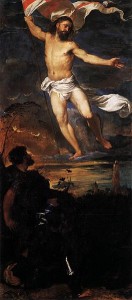
One of my favourite books in my collection of history books is a copy of French Reformer Jacques Lefèvre d’Étaples’ book Epistres et Evangiles pour les cinquante et deux semaines de l’an (Epistles and Gospels for the 52 Weeks of the Year). It is a special book for me because Anne Boleyn was given a beautiful illuminated manuscript of Lefèvre’s work by her brother, George Boleyn, Lord Rochford. It is written in old French but I find it worth the brain strain to read what Anne and her brother were reading in the 1530s.
I quite often dip into it and I picked it up this morning to see what Anne Boleyn would have been reading on Easter Sunday, or “Dimanche de Pâques”. As it’s written in French, and old French at that, I thought it would be easier to share the texts with you as they were written in Tyndale’s Bible, another book that Anne owned. Lefèvre also shared an “exhortation” but I will leave you to ponder the readings for yourself.
Epistle – 1 Corinithians 5: 7-8
“Pourge therfore the olde leven that ye maye be newe dowe [dough] as ye are swete breed [bread]. For Christ oure esterlambe is offered vp for vs. Therfore let vs kepe holy daye not with olde leve nether with the leven of maliciousnes and wickednes: but with the swete breed [bread] of purenes and truth.”
Gospel – Mark 16: 1-7
“And when ye saboth daye was past Mary Magdalen and Mary Iacobi and Salome bought odures that they myght come and anoynt him. And erly in the morninge the nexte daye after the saboth day they came vnto the sepulcre when the sunne was rysen. And they sayd one to another: who shall rolle vs awaye the stone from the dore of the sepulcre? And when they looked they sawe how the stone was rolled awaye: for it was a very greate one. And they went into the sepulcre and sawe a yonge man syttinge on the ryght syde cloothed in a longe whyte garmet and they were abasshed. And he sayd vnto the be not afrayed: ye seke Iesus of Nazareth which was crucified. He is rysen he is not here. Beholde the place where they put him. But go youre waye and tell his disciples and namely Peter: he will goo before you into Galile: there shall ye se him as he sayde vnto you.”
Whatever your beliefs about the story of Christ, his crucifixion and resurrection, Anne Boleyn had a true faith and I’m sure she would join me in exchanging the traditional Easter greeting: “Christ is risen!”, “He is risen indeed, Alleluia!”
I wish you, your family and friends a very Happy Easter.
Easter Sunday in Tudor Times
On Easter Sunday, the candles in the church and around the sepulchre were extinguished, and then the church lights were re-lit by the priest, from a fire. The sepulchre was opened, and Christ’s resurrection was celebrated with a special mass.
The Easter Sunday mass marked the end of Lent, a period where people’s diets were restricted, so it was only natural to celebrate it with good food. Dairy products and meat were back on the menu, and people enjoyed roasted meats like chicken, lamb and veal.
On this day in history…
- 1531 – Richard Roose (or Rouse), the cook on the household of John Fisher, Bishop of Rochester, was boiled to death after being attainted of high treason. It was claimed that Roose had poisoned a porridge (or pottage)* served to Fisher and his guests on 18th February 1531. All who ate the porridge became ill, and two people died. Click here to read more about it.
Notes and Sources
- Epistres et Evangiles pour les cinquante et deux semaines de l’an – My copy was published in 1976 as Epistres et Evangiles pur les cinquante et deux dimanches de l’an, edited by Guy Bedouelle and Franco Giacone.
- William Tyndale’s translation of the Bible – this can be read online at Wesley Centre Online.